The Bedfordshire Regiment in the Great War

'Other Ranks' Photographs and Biographies from the 5th Battalion
Private 2645, later 32130 Joseph Hack
Joe was born into a large family in January 1893, to James and Julia Hack of Heath and Reach, Leighton Buzzard, Bedfordshire. He was the younger brother of my own great grandmother, Ellen Elizabeth Hack. On the 21st March 1910, the 17 year old Sand Pit Worker enlisted into the 5th Territorial Battalion of the Bedfords as Private 2645, and went to their Summer camps in Ipswich (July 1910), Brentford (July 1911), Worthing (July 1912) and Shorncliffe (July 1913).
Having already agreed to serve oversees after the Brentford Camp in 1911, Joe was embodied with the 5th Bedfords when war broke out in August 1914 and saw the influx of new recruits - including his brother in law Herbert Charles Kendall - that Autumn swell the ranks to almost 1,000 soldiers. After serving on the Anglian coast on Home Defence duties whilst training continued, Joe sailed with the Battalion to Gallipoli in July 1915.
They landed on the peninsula August 11th and saw their first battle on the 15th (see here for a full story) but Joe was one of the 300 casualties. Once he had recovered enough to be shipped home, he was transferred to Norwich hospital in November 1915 to continue his convalescence. By July of 1916 he was well enough to be posted to the 3rd/5th Battalion where his retraining started. That month he also married Edith Petts who he met at Norwich and a year and 2 days later their first child was born - Joseph Henry Hack.
By November 1916 he was passed as fit enough to serve abroad again and posted to the 6th Battalion, arriving in France as Private 32130 on the 28th November 1916. Following final training around Etaples, he arrived with his new comrades in the front line on 11th December and held the line and trained for the forthcoming offensives around Arras in 1917.
The Battalion were involved in the Arras offensives around Monchy-Le-Preux on the 10th April 1917 and again when they attacked Greenland Hill in the snow on the 28th. Joe was one of the massive casualty list inflicted on the Battalion at Greenland Hill, where only 58 men came out of the attack.
Joe suffered dreadful injuries during the battle including a Gunshot wound to his face, severe injuries to his right hand (losing his third finger) and the surgeons had to amputate the left leg below his knee. Despite the agony, he survived and returned home on the 13th May to convalesce. By 15th May 1918, it was obvious that Joe would never serve in the army in any capacity again, so he was discharged, having served in the regiment for 8 years. He returned to Heath and Reach near Leighton Buzzard where he carried on with life. After the war Joe and his brother ran Rammamere Farm near Heath and did various jobs including returning to the Sand Pit just outside the village. In 1926 he moved with his family to the cottages at Fox End, Heath, where he stayed until his death.
Joe's granddaughter Andrea tells me he put surviving his dreadful injuries down to being a tea totaller and never smoking during his life.
For his service to King and Country, Joe was awarded the 1915 Star, Victory and British War medals and a Silver War Badge. Sadly I have no picture to complete this short resume but would welcome one if it should be available!
|
Nathan and Albert Payne
A report later suggested they were killed by the same land mine whilst withdrawing from the furthest point the battalion reached, on Kidney Hill itself. |
Frederick Harold Goodship
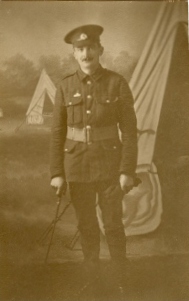
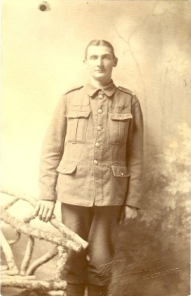
This is Frederick Harold Goodship was born in 1889 in White Hill, Bedfordshire and married Dorothy King of 169 Hightown Road in Luton on the 8th May 1914 at St. Matthews Parish Church in Luton. At that time Frederick lived at 77 Magpie Road in Norwich.
In September 1914 Frederick and his brother Horace enlisted at the Luton Corn Exchange, both being recorded as Ramridge End boys. They were posted into A Company of the 1st/5th battalion and trained until going to Gallipoli in August 1915. Although they both came through the first battle on the 15th August 1915, during which A Company were decimated, Private 3840 Horace Goodship was killed the following day and is remembered on the Helles Memorial to the missing. Frederick seems to have been either wounded or ill and returned to England to recover, after which he was posted to the 12th battalion of the Royal Irish Rifles and was killed at Kemnel Ridge on the 15th April 1918. He has no known grave either and is remembered on the Tyne Cot Memorial to the missing.
Frederick can be seen in A Company's group photograph here, taken before near Bury St Edmunds early in 1915, the second form the left, middle row. Horace seems to be the eight from the left, second row from the top, with his hands on another man's shoulders. The Officers in the shot are Brian Cumberland who was killed in their first battle leading his men from the front, despite a badly broken arm and Lieutenant Andreini, the competent, cheeky, suave and crafty battalion Quartermaster at the time! Frederick remarks in the postcard to his wife that his officer had them taken and how 'it was very good of him' as they 'only cost 2d each'.
The embroidered regimental standard was made by Frederick whilst at hospital in Hove 'at Christmas', which is also where the hospital ward photograph was taken. Frederick is in bed on the right with the very embroidery as he was making it.
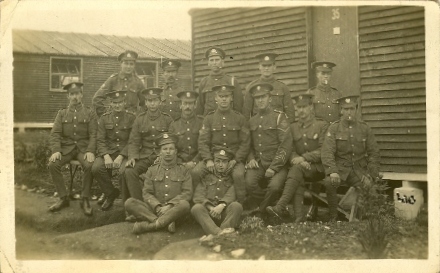
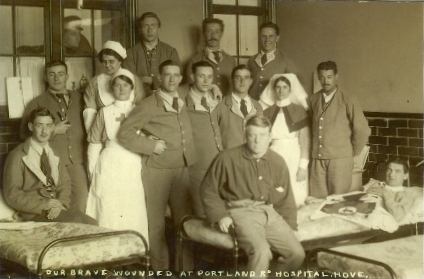
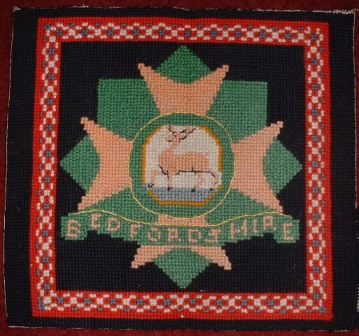
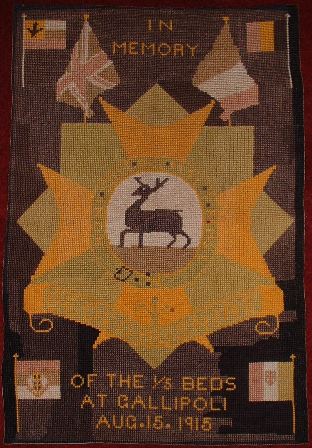
Lance Corporal 3025 Percy John COLLWELL, MM
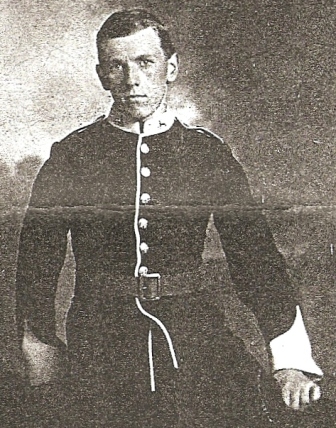 [Please
consult Percy's relatives through me before using any of the items in
this story as they are the owners of the material].
[Please
consult Percy's relatives through me before using any of the items in
this story as they are the owners of the material].
Percy Colwell was born 1892 or 1893 in Codicote (now Caldecote), Hertfordshire, the son of George and Lizzie (nee Barnes).
He enlisted into the 5th Battalion late in 1912 or early in 1913 and was embodied for foreign service in August 1914 when war was declared.
After training and duties in East Anglia, he landed on Gallipoli with the battalion on the 10th August 1915.
Apparently surviving the campaign in relatively good health, he transferred into the Machine Gun Corps sometime in 1916 as Private 48355, where he would remain attached to the 5th Bedfords.
Private Colwell became a Lance Corporal and made it through the entire was without a scratch, despite throwing himself on a hand grenade to save his comrades when it landed in their trench.
That and his coolness during a heavy Turkish counter attack won him the Military Medal during the 3rd Battle of Gaza, whilst in the MGC attached to the 1st/5th Bedfords.
Percy was disembodied from service in March 1919 and returned home.
After the war Percy worked in Luton until the death of his father led to him taking over as Landlord of The Carpenter's Arms public house in Harlington.
He remained the landlord until his own death on the 28th December 1960 at hospital in Luton.
Unusually, Percy took a camera with him to war.
As a result, we have the photographs below recording moments in time from his war.
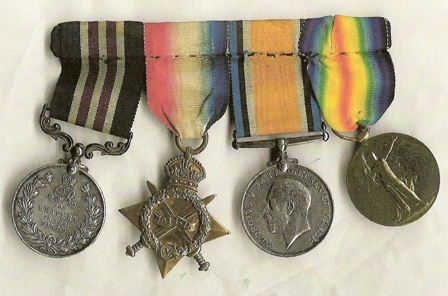
Percy's medals, being the MM, the 1914/15 Star, Victory and British War Medals
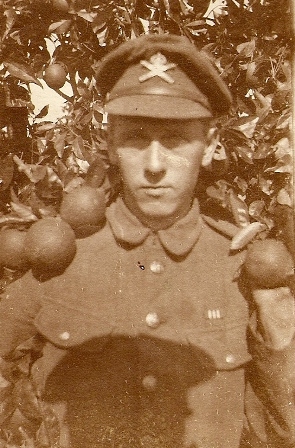
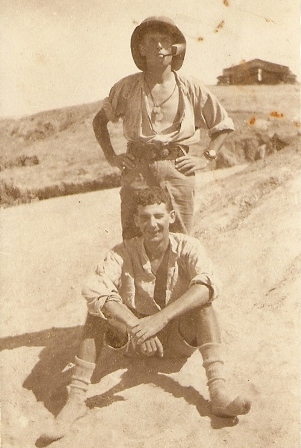
Above is Percy wearing the local 'Orange Tree camouflage' in addition to his Military Medal ribbon, so is presumably from 1918. On the right are Percy and a mate, with Percy being the one standing enjoying his pipe
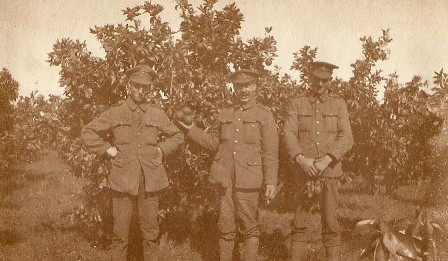
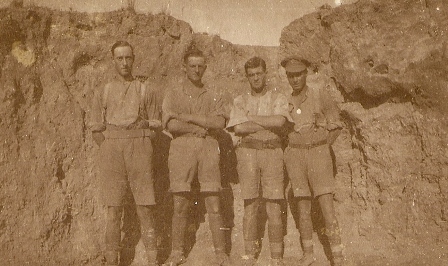
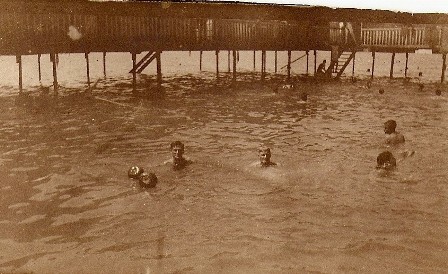
Various shots in an Orange grove, a deep trench and enjoying a spot of bathing!
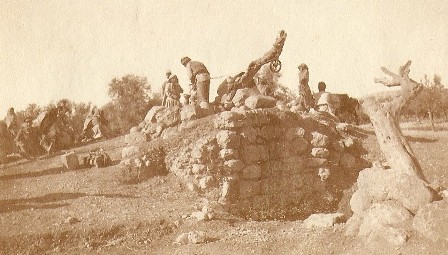
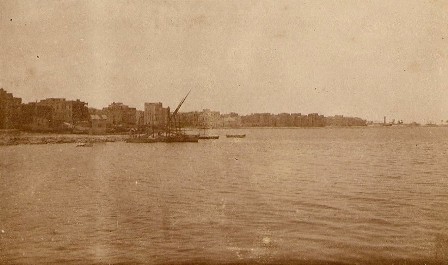
To the left seems to be locals operating one of the army's water wells with the right side presumably a photo of the Suez Canal, either whilst stationed there in 1916 or perhaps after hostilities had finished in 1919.
Lance Corporal 5459, later 200985 Phillip Herbert WATKINS
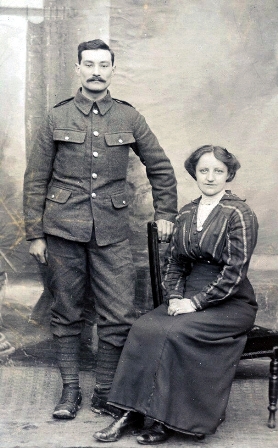 Phillip
had been born in Belgium in 1890, the son of William and Milly Watkins,
although his birth was registered in Croydon in the following year. He
was shown on the 1901 census as a resident pupil at Stubbington House
School for boys in Segensworth, Hampshire.
Phillip
had been born in Belgium in 1890, the son of William and Milly Watkins,
although his birth was registered in Croydon in the following year. He
was shown on the 1901 census as a resident pupil at Stubbington House
School for boys in Segensworth, Hampshire.
He married Maud Lawrence who, in 1901 had been living at the family home of 115 High Town Road in Luton and working as a Straw Hat Finisher.
Phillip enlisted into the army from Luton late in the summer of 1915 and became Private 5459 of the 5th battalion, the Bedfordshire Regiment. The only known surviving photograph of Phillip and Maud from the First World War (above) shows Phillip during his training, probably not long before he was sent to the front.
Following training, Phillip would have been shipped out to join the battalion in Egypt, probably arriving with them in one of the drafts sent to rebuild the battalion in February 1916, after their involvement in the Gallipoli campaign. There is one surviving communication from him written on a Church Army Recreation Hut postcard dated the 31st May 1916, when the battalion were working on the Suez Canal defences. Doubtless written after a long day's work in the heat, it is addressed to Maud's brother Herbert (Phillip's brother in law);
"Dear Herb and Ethel. Am all alive and kicking. This is a terribly hot climate which gives one a terrible thirst but with a bit of luck we shall all pull [through] this. Not allowed to say any address but Maud will give it to you. Love to yourselves and Hedley. Yours Philip."
After almost a year spent in and around the Suez Canal, the army were moved onto the offensive and marched towards Gaza. About this time the Territorial Army soldiers were renumbered (March 1917) and Phillip became Private 200985.
The British and Commonwealth soldiers arrived opposite the Gaza defences and Phillip survived the first two Battles of Gaza before settling into what would become his first experience of trench warfare, given that the time spent along the Suez Canal was unopposed. Aggressive patrols, rebuilding trenches and skirmishes with Turkish patrols in no man's land became the norm during the hot summer of 1917 until training for a large scale raid on Turkish positions began on the 10th July.
On the 20th July, Phillip and around 230 of his comrades raided Turkish positions on Umbrella Hill and Lance Corporal Watkins was one of the 24 Bedfords who lost their lives during the fighting. He was probably killed as the men retired from their successful raid and ran straight into a huge Turkish barrage that hit their assembly area.
Lance Corporal Watkins was buried behind the British lines after the raid and moved to the Gaza War Cemetery in Israel in the 1920's. He was posthumously awarded the British and Victory medals.
His wife Maud lived at 14 Highbury Road in Luton, Bedfordshire after the war and was married to Herbert J. Butler again at the end of 1922. (With thanks to Phillip and Maud's relative, Matthew Butcher, for the family information and photograph)
Site built by Steven Fuller, 2003 to 2023
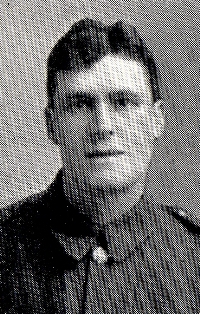
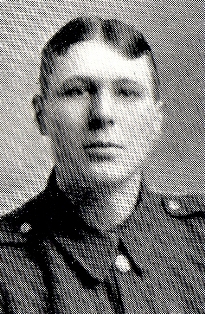 Nathan
Payne (left) and Albert Payne (right) were brotehrs who were both
both killed on the Gallipoli peninsular, on the
Nathan
Payne (left) and Albert Payne (right) were brotehrs who were both
both killed on the Gallipoli peninsular, on the